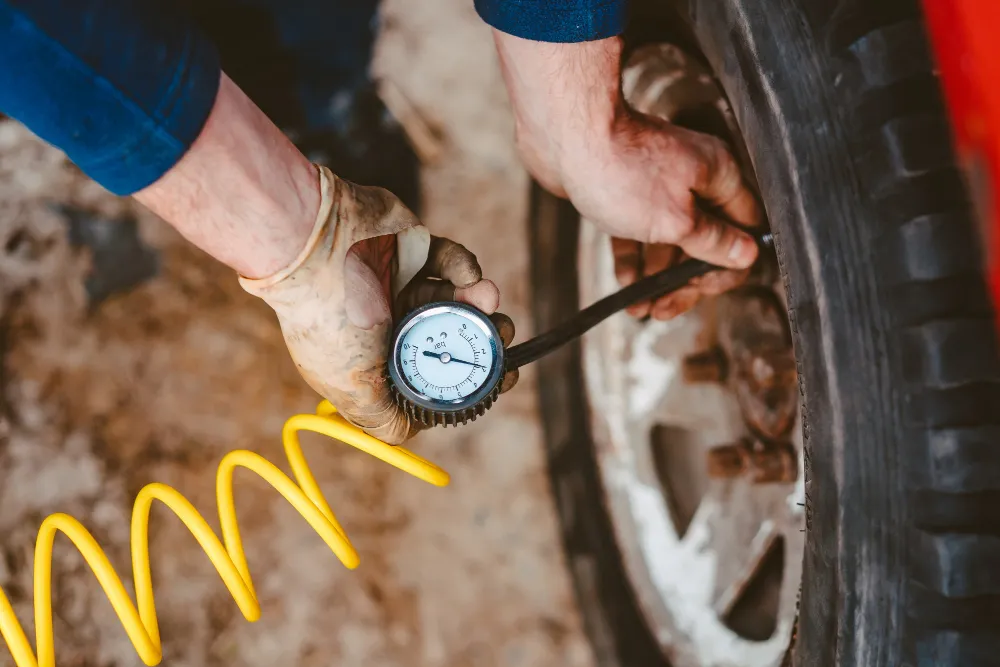
Many drivers only think about tyre pressure when something goes wrong, like when a dashboard light pops up or a tyre looks flat. But maintaining the right tyre pressure is one of the simplest and most effective ways to keep your car running safely and efficiently. The question is, how often should you really Tyre Pressure Check? Let’s look at why it matters, what experts recommend, and how regular checks can save you time, money, and stress on the road.
Why Tyre Pressure Check Matters
Tyres are your vehicle’s only point of contact with the road, so their condition directly affects handling, braking, and fuel economy. When tyres are inflated to the correct pressure, they grip the road evenly, giving you better control and improving braking distance.
However, when tyre pressure is too low or too high, several issues can arise:
- Underinflated tyres cause poor fuel efficiency, uneven tread wear, and reduced stability. They also generate more heat, increasing the risk of a blowout.
- Overinflated tyres can make your ride harsh and bumpy. They reduce traction and wear out faster in the centre of the tread.
Maintaining the Tyre Pressure Check isn’t just about comfort—it’s about safety and cost savings.
How Often Should You Check?
According to most automotive experts and tyre manufacturers, you should check your tyre pressure at least once a month and before any long journey.
This recommendation might surprise drivers who rely solely on their car’s tyre pressure monitoring system (TPMS). While TPMS alerts you when pressure drops significantly, it doesn’t always warn you about gradual losses or small differences between tyres.
Factors like temperature changes, road conditions, and driving habits can cause tyres to lose air slowly over time. For example, in the UK, temperature fluctuations between seasons can cause pressure to drop by as much as 1 PSI (pound per square inch) for every 10°C decrease.
That means even if you filled your tyres last month, they could already be below the recommended level today.
The Right Way to Check Tyre Pressure
Checking tyre pressure properly takes only a few minutes and can make a big difference in performance. Here’s how to do it:
- Use a reliable gauge: You can use a digital or manual pressure gauge. Many fuel stations and mobile tyre services also offer quick pressure checks.
- Check when tyres are cold: Measure pressure before driving or after the car has been parked for at least three hours. Heat from driving increases pressure temporarily and can give false readings.
- Compare with the manufacturer’s recommendation: You’ll find the correct Tyre Pressure Check listed in your car manual, on a sticker inside the driver’s door, or near the fuel cap.
- Adjust as needed: Add or release air to match the recommended PSI. Don’t forget to check your spare tyre too.
Regular checks help you spot slow leaks early, preventing unexpected flats or tyre damage.
The Cost of Ignoring Tyre Pressure
Neglecting tyre pressure might not seem serious, but the consequences can be expensive and dangerous. Here’s what can happen:
- Higher fuel consumption: Underinflated tyres increase rolling resistance, which forces your engine to work harder. This can raise fuel use by up to 3%.
- Faster tyre wear: Incorrect pressure causes uneven tread wear, shortening the lifespan of your tyres.
- Reduced safety: Poor pressure affects braking distance and cornering stability, especially in wet conditions.
- Greater risk of breakdowns: A slow leak or damaged tyre can easily lead to a roadside emergency.
Many of the callouts handled by mobile tyre repair services like GripGo Tyres involve preventable punctures or blowouts caused by underinflated tyres. Regular checks could help drivers avoid most of these situations.
How Mobile Tyre Services Can Help
Life gets busy, and not everyone remembers to check tyres regularly. That’s where professional mobile tyre repair services come in.
Companies such as GripGo Tyres provide 24/7 on-site assistance for puncture repairs, straight tyre repairs, and emergency callouts anywhere in the UK. Their technicians can Tyre Pressure Check, inspect for leaks, and ensure your tyres are road-ready—all without you having to visit a garage.
For drivers who want peace of mind, scheduling a monthly mobile tyre inspection can be a smart move. It ensures your tyres are properly inflated and helps identify minor problems before they become costly repairs or safety risks.
Seasonal Factors That Affect Tyre Pressure Check
In the UK, changing weather conditions can have a big impact on tyre performance.
- Cold weather: Pressure drops as temperatures fall, often triggering warning lights in winter.
- Hot weather: Air expands in warmer temperatures, potentially causing overinflation.
- Rainy conditions: Proper pressure is essential for maintaining traction and preventing hydroplaning on wet roads.
That’s why it’s especially important to check your tyres during seasonal transitions—early winter and late spring are key times.
The Bottom Line
Tyre Pressure Check seem like a small detail, but it has a big impact on your safety, fuel economy, and driving comfort. Checking your tyre pressure once a month and before long trips is a simple habit that can prevent breakdowns and keep your car performing at its best.
If you’re unsure or short on time, mobile services like GripGo Tyres are always ready to help, offering quick, professional tyre checks and emergency repairs right where you are.
A few minutes of maintenance today can save you a lot of trouble tomorrow.

